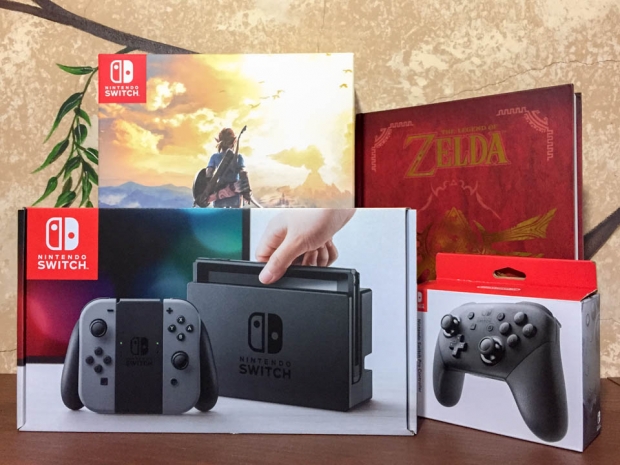Index
Nintendo DS sticks around while flexible motion controls are in
Earlier this month, Nintendo introduced one of the most groundbreaking product designs it has put together since the Wii was released back in 2006. With a lightweight and fairly modern build quality, flexible controller options and a design reflective of a rather creative, non-OEM Shield tablet, the company has managed to outsell its competitors and rethink the boundaries of home and portable gaming.
History: Taking integrative design elements from the Wii
During E3 2004, Nintendo was at a design intersection on how to reinvent the modern home gaming platform to better suit an increasingly Internet-connected world while remaining relevant in the console market. The solution was to release a system not only with online service features, but also with an untethered controller design allowing users to get up off the couch and physically interact with their immediate room environments. The company released the Wii in November 2006 as a precursor to modern living room motion controller setups, allowing gamers the flexibility to switch from a couch gameplay setup to full immersion with the display through the use of expressive arm and limb movements.
Although many critics would argue that the Wii did not live up to its “Revolution” codename because of awkward motion controls and its tendency to attract “too many” casual gamers, others viewed its signature Wii Remote and Nunchuck as an innovative motion-based control scheme that immensely lowered the learning curve. The Wii Remote, a fusion between a NES controller and a television remote control, was also regarded as a “clever step” compared to using a traditional remote control that required learning not only how to control characters on screen, but how to control the controller itself.
After ten years on the market, the Wii became the best-selling home console of its respective generation of hardware, outpacing the Xbox 360 and PS3 despite Microsoft’s nearly one-year lead, though not quite winning the “living room” war on its own. Most gamers still insisted the Wii was too casual of a console and did not integrate well enough with the quality demands of emerging home theater setups during the time.
Then in 2012, the company introduced a successor in the form of the Wii U, complete with its own gamepad allowing for asymmetric gameplay, additional access to menus, and easy access to inventory. The gamepad was criticized, however, for being too bulky, containing L and R buttons slightly out of reach, and not ideally compact enough for holding comfortably during extended periods of time. In addition, some users criticized the lack of battery life and ability to have extended mobile gaming sessions.
Nintendo Switch announced as first “truly hybrid” Nintendo console
Nintendo took the criticisms seriously over the remaining lifespan of its latest asymmetric gamepad living room console and by October 2016, it was ready to announce the fruits of it labor in the form of a completely refreshed unit extended into two individual market segments. The Nintendo Switch appeared during a press conference in Japan as a representation of years of industry efforts to merge the entertainment value of room-based motion controllers with the appeal of a more streamlined gamepad for extended gameplay navigation and remote access. Not only did it simplify the design of the Wii U for the home gaming market, but it now traverses into the mobile category by offering untethered entertainment as a standalone replacement for the Nintendo DS series, the global smartphone market, and competing devices such as the Nvidia Shield Tablet (Kepler) and PlayStation Vita.
Unboxing
The Nintendo Switch was introduced on March 3 in the United States as a standalone unit without any bundled games, nor with any pre-loaded games or game demos. During the company’s press conference in October 2016, president and chief operating officer Reggie Fils-Aimé said that Nintendo would be allowing consumers to choose which games to purchase rather than including one in the bundle and increasing its base price.
The unit we purchased from GameStop included the tablet console itself, one right Joy-Con controller, one left Joy-Con controller, two Joy-Con wrist straps, the Joy-Con grip, the Nintendo Switch dock, one High-Speed HDMI cable, and an AC adaptor.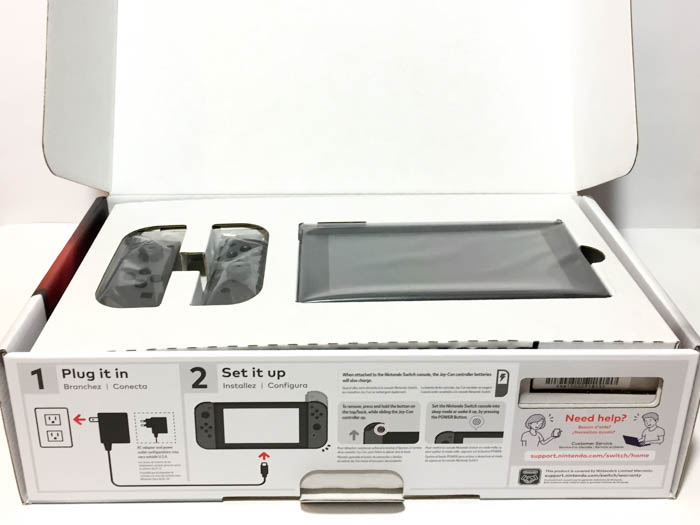
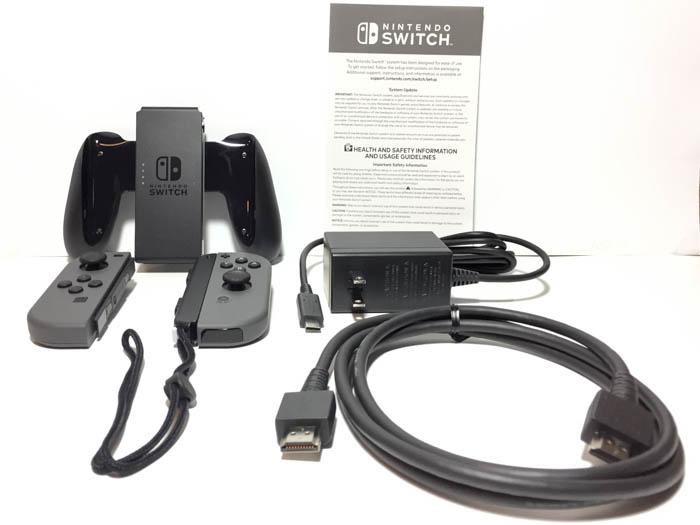
Another item purchased was the Nintendo Switch Pro Controller, which includes motion controls, HD rumble, and built-in amiibo functionality.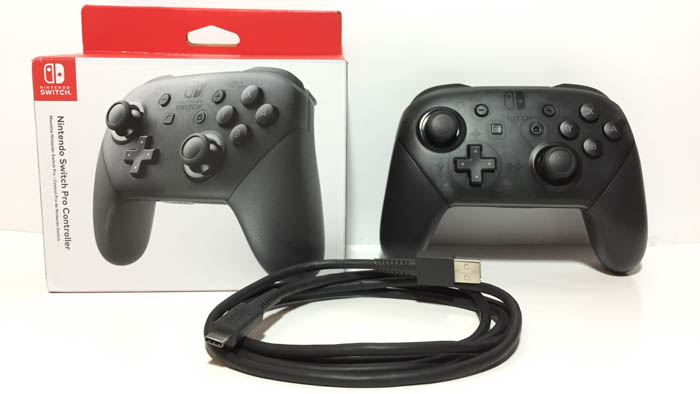
Additionally, we picked up The Legend of Zelda: Breath of the Wild Special Edition, which included a slate carrying case, a Sheikah Eye Collectible Coin, a Relic of Hyrule: Calamity Ganon Tapestry and Weather-Worn Map, and a sound selection CD.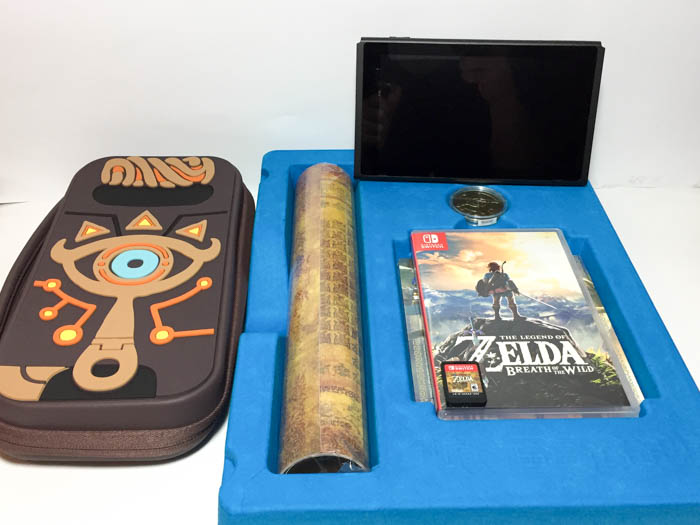
Console
The Switch console unit runs a standard Nvidia Tegra X1 T210 processor (Maxwell) with four 2.0GHz Cortex-A57 cores and a GM20B graphics core. Other specifications include 4GB of LPDDR4 memory, 32GB of flash memory, 802.11ac wireless connectivity, Bluetooth 4.1, a 3.5mm earphone jack, one USB-C port, one USB 3.0 port, and two USB 2.0 ports. The included battery is a 4,310mAh lithium-ion battery cell that takes approximately 3.5 hours to fully recharge from a depleted battery.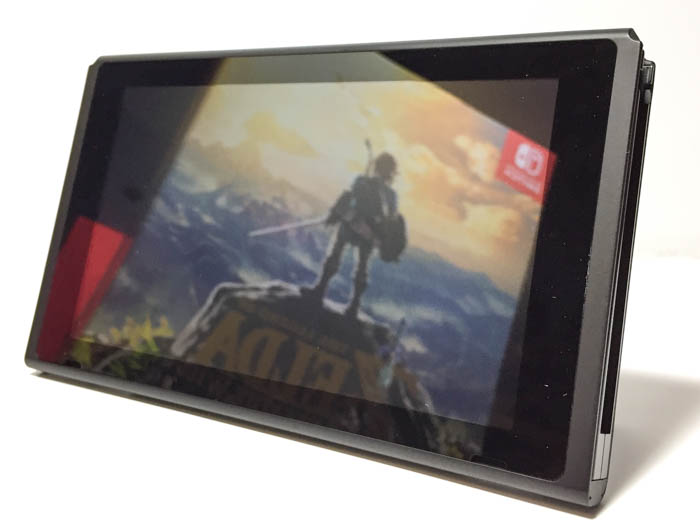
The tablet itself measures 239mm wide, 102mm tall and 14mm deep (9.41 x 4.02 x 0.55 inches) and features a 6.2-inch IPS display with 1280x720p resolution. There are noticeable bezels around the screen itself, which some have attributed to either power consumption or cost savings.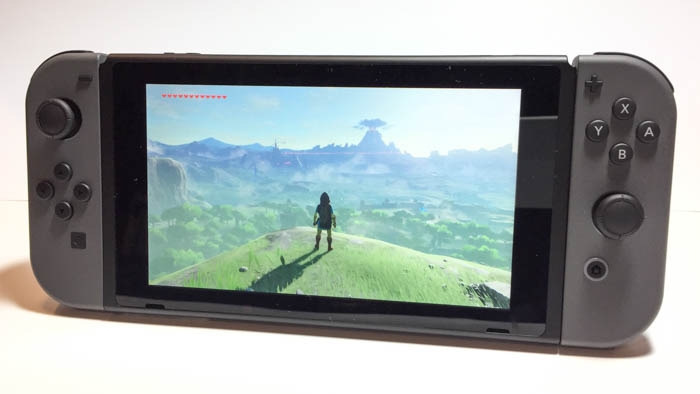
In comparison, the Nvidia Shield Tablet K1 (Kepler) measures 220mm tall, 130mm wide, 9.1mm deep (8.66 x 5.12 x 0.36 inches) and features a 5-inch display. The tablet features an Nvidia Tegra K1 (Kepler) processor with four Cortex A15 R3 cores running at 2.2GHz each, and operates at 5V with 2A.
The console unit contains both a power button and adjacent volume buttons in the top left corner, a 3.5mm audio jack and game card slot on the top right corner, two speakers on the bottom, and a brightness sensor at the bottom of the display bezel.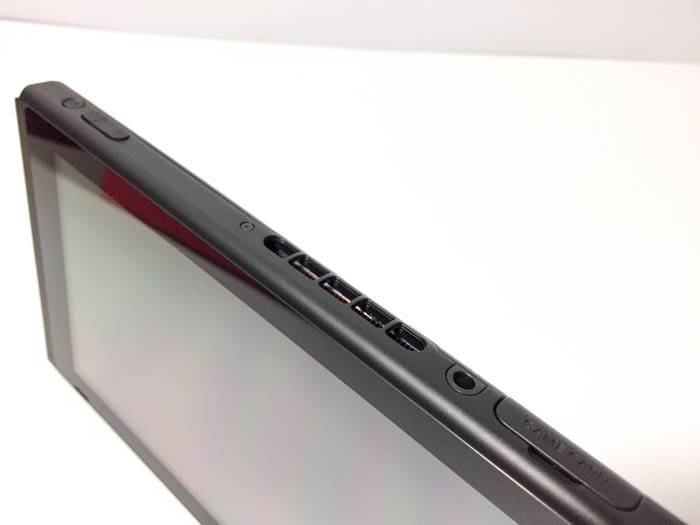
On the back of the console unit is a miniature kickstand, a microSD card slot up to 2TB in capacity, and a USB Type-C connector, while the sides of the console feature two slotted rails for inserting the Joy-Con controllers.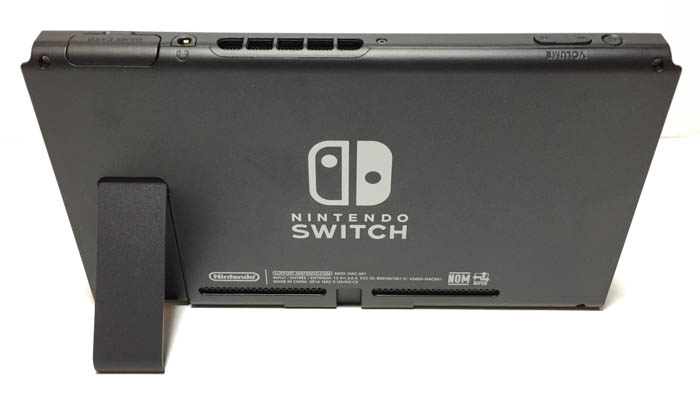
Power
Although the device does not support QuickCharge protocols, it does utilize the next-generation USB Power Delivery 2.0 standard featuring 5V, 9V, 15V and 20V operational modes. According to AnandTech, the Switch’s power adapter runs at 15V, though the console itself is limited to pulling 2A regardless of voltage. According to IGN, the Nintendo Switch is capable of charging a MacBook Pro over USB-C when plugged into one of the notebook’s Thunderbolt 3 ports. This is presumably also the case for other USB-C enabled notebooks, though mileage may vary.
Joy-Con Controllers
The left Joy-Con controller features dedicated “L” and “ZL” buttons at the very top, a minus (-) button and left stick control at the top, directional arrows towards the center, and a capture button used to capture images during a game. The controller can also be used in the horizontal position for additional controls, which include an “SL” button and an “SR” button along with a console “Sync” button and player LEDs to indicate which player has been assigned to the controller.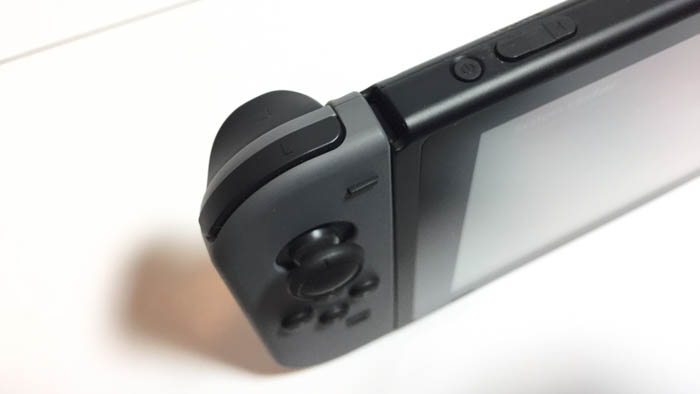
The right Joy-Con controller features dedicated “R” and “ZR” buttons at the very top, a plus (+) button and right stick control at the top, A, B, X, Y buttons towards the top, a right stick control towards the center, a Home button, and an IR motion camera towards the bottom. The controller can also be used in the horizontal position for additional controls, which include an “SL” button and “SR” button.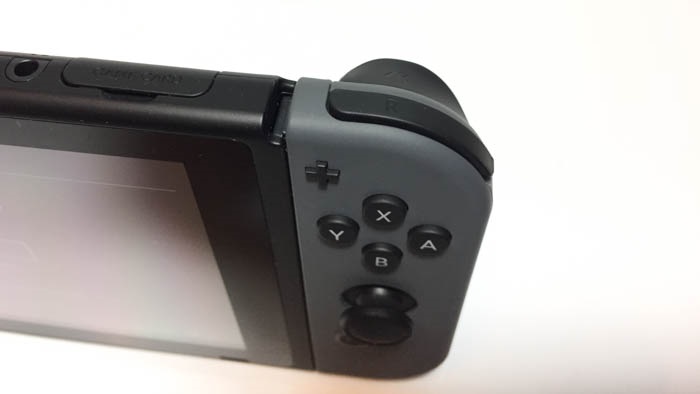
Each controller slides into the left and right slotted rails on the sides of the Nintendo Switch. When controllers are attached, the full console weighs less than one pound and is significantly easier than the Wii U gamepad controller to handle for long periods of time.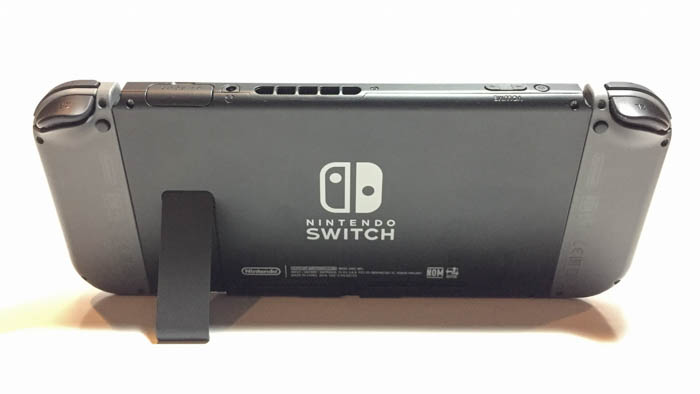
Conveniently, both Joy-Con controllers also work natively with Android, PC and Mac, but will require a third-party app to get each operating system to recognize the button arrangements.
Nintendo Switch Pro Controller
The best way to describe the Nintendo Switch Pro Controller is a refined alternative to using the Joy-con and Charging Grip configuration for those wishing to play with a more conventional controller layout. The design includes two analog control sticks on the top left and bottom right, an eight-way directional Control Pad, four shoulder buttons, along with Home, Plus, Minus and Capture buttons in the center.
The controller includes motion controls, HD rumble, amiibo functionality and weighs 14.1 ounces (0.4kg) – just an ounce under the Xbox Wireless Controller (15.2oz / 0.13kg) and just over double the weight of a DualShock 4 controller (6.77oz / 0.19kg).
Docking Station
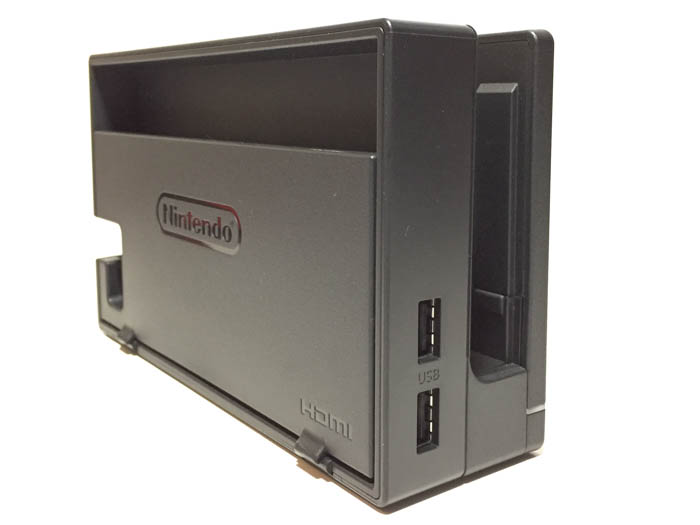
The included Nintendo Switch docking station measures 173mm wide, 104mm tall and 54mm thick and weighs 11.53 ounces (327g). The unit features two USB 2.0 ports on the front and features a flip-open back cover revealing three additional ports – one USB 3.0 port, one HDMI 2.0 port, and the AC adapter port.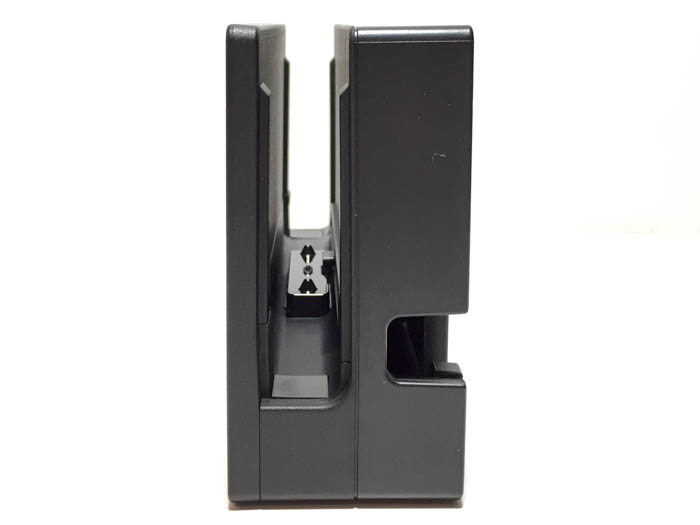
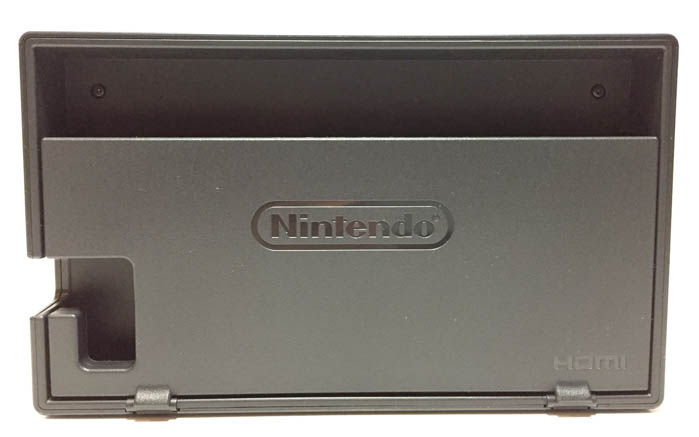
The docking station uses USB Type-C to mount the Switch console and when installed, connectivity is indicated by a green TV-Out indicator light next to the front USB 2.0 ports. The docking station can support resolutions up to 1080p and a maximum frame rate of 60 frames per second, though resolution can vary depending on the game. For instance, The Legend of Zelda: Breath of the Wild runs at a maximum 900p and 30fps while the console is docked, though is capable of outputting 720p in portable tablet mode.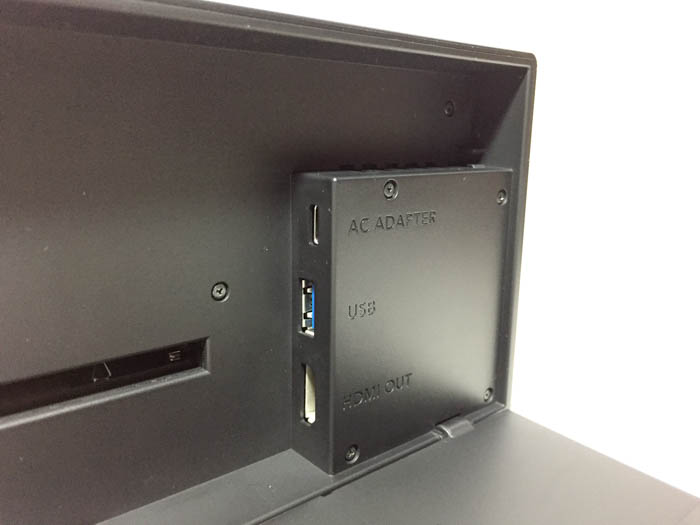
When docked, the Switch takes approximately 3 hours to charge when powered off or in sleep mode.
Aesthetics
In terms of aesthetics, the Nintendo Switch features a fairly straightforward tablet design that could be slimmed down just a bit with the removal of its bezels, though the laws of consumer product cycles tell us that Nintendo may likely redesign the console at a later point once the first generation has been on the market for at least two years. The company’s Nintendo DS lineup saw refreshes once every eighteen to thirty months. Now that this console merges the boundaries between household and portable device groups, it is possible that the company could opt for a quicker release cycle than the traditional 4 to 6 years its home console lineup has experienced.
General Operation
For home console use, the device mounts into the included Nintendo Switch docking station and operates in “TV Mode” to support display on a large television screen. In this mode, the device can output full 1080p resolution, though it appears the initial batch of launch titles will run at 900p.
As for clockspeeds, the Switch’s standard Tegra cores are capable of running at 1020MHz, though early reports have noted that the GPU will only ever hit 768MHz at best. This is considerably lower than the 1GHz speeds of Nvidia’s Shield Tablet K1, and already lower than the PlayStation 4 and Xbox One. The embedded memory controller runs at 1600MHz while docked, though in undocked usage this number drops down to 1331MHz.
The bigger surprise, however, is that the GPU significantly downclocks from 768MHz in docked mode to 307.2MHz in undocked mode – or a 40 percent difference to significantly save power. The company has decided that it will allow developers to safely ignore GPU clockspeeds even while the console is docked, allowing games to run at the lower frequency in full resolution television mode.
In docked mode, the console features a GPU with about 2.5x more power over the same unit running from battery. In theory, this is enough headroom to run a 720p mobile title at 1080p while docked, similar in concept to producing a PS4 game and a PS4 Pro game. In retrospect, even the downclocked 307.2MHz clockspeeds should be capable of outperforming the Wii U’s 550MHz graphics core from four years ago.
System Menu
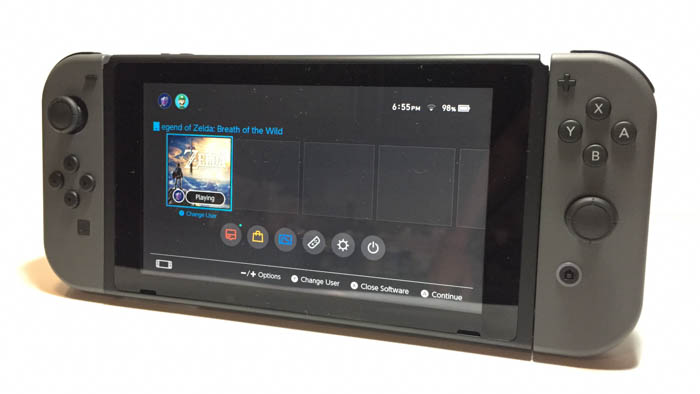
Upon powering on the console, the user is greeted with a menu interface composed of six primary selection settings – News, Nintendo eShop, Album, Controllers, System Settings, and Sleep Mode. The top right corner shows the time, network connection status and battery life, while the bottom left shows the connected controller status. At the top left corner is the user Pages menu that will toggle between up to eight user profiles. Currently, there are options to set Parental Controls without the Parental Controls App, and Facebook can be used for logging in to find friends and share screenshots. The console does not include any Web browsing functionality at launch, however, as the company has decided to make this a dedicated gaming platform for the time being.
When asked about the absence of Mii characters and applications not transferred from previous consoles, Nintendo President Tatsumi Kimishima explains:
“In terms of the applications available on Wii U, all of those are not necessarily transferred or installed. In principle, we think about which application needs to be improved or discontinued by looking at consumers' reactions.
“As for Miiverse, while Miiverse will continue to be supported on the Wii U and Nintendo 3DS systems, our approach with the Switch is to make greater use of other established, broadly used social platforms.”
According to EuroGamer, the console is also capable of unlocking additional menu space if you own more than a dozen games. The site reveals that playing a 13th game on the system uncovers a new “all software” option at the end of the home screen’s horizontal games menu. At this point, the full games library can be displayed without the need to scroll sideways.
In addition, the console also supports plugging USB keyboards into the Switch Dock to use for editing text on photos.
Gameplay
Each Nintendo Switch game arrives in cartridge form called a Game Card measuring 35mm wide, 33mm tall and 3.8mm thick (1.38 x 1.30 x 0.15 in). These are the same physical size as the cards used on the DS, DSi and 3DS, but now feature up to four times more storage capacity.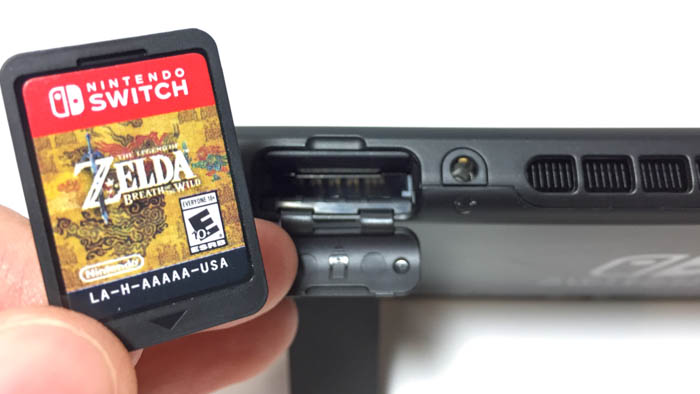
Gameplay in The Legend of Zelda: Breath of the Wild is reminiscent of a hybrid between The Legend of Zelda: The Wind Waker and The Legend of Zelda: Skyward Sword, but in a much more open and expansive world. Link can scale walls, use hang gliders, ride a variety of horses except for Epona, shoot bow and arrows, cooking, play various musical instruments with magical effects, swap out worn down weapons arsenal to fend off enemies, and gather valuable resources. For this game, it is more ideal to use the Nintendo Pro controller over the Joy-Con controllers because of its larger hand grip, D-Pad and button layout. There is also relatively little to no input lag when using this controller.
Weapon durability is one of the more challenging aspects of the game, as items like the Guardian sword tend to break and a player’s inventory will mostly be filled with the same item – like clubs – for an extended period of time. One effective method of combating enemies, however, is to learn how wind, fire and other in-game elements have an effect on combat. For instance, throwing a bomb with the direction of the wind will be useful for opening gates or taking down enemies, while fire can spread in suitable locations for taking down larger structures.
There are also plenty of peaks and ranges to survey wide swaths of landscape and plan excursions into uncharted waters, mountains, forests, shrines, islands, stables, ranges and plains. The days when Hyrule acted as a central hub to connect various towns and plains in the game is now over. Climbing is perhaps one of the more acclaimed features in this game, and many expect it to become a cornerstone for successive releases in the franchise.
Gameplay Performance
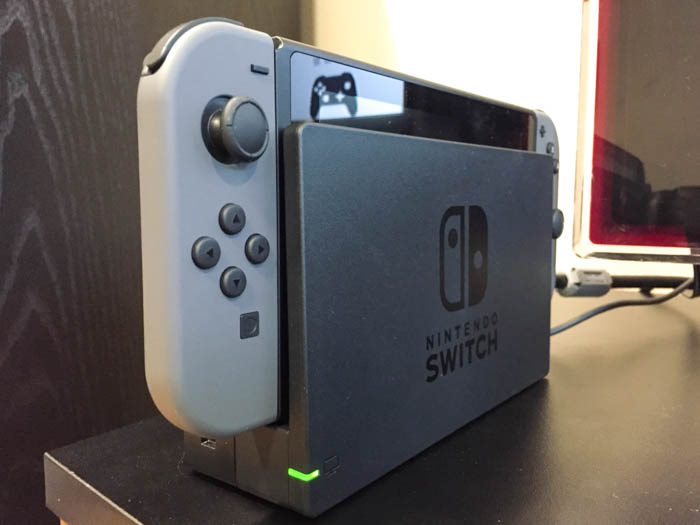
In the first few minutes of playing The Legend of Zelda: Breath of the Wild in docked mode, there was not much in the way of framerate drops or input lag. In complex environments with significant foliage and shading, the game maintains an moderately average 30fps threshold, though not low enough to remind us of the 20fps average from Ocarina of Time running on the Nintendo 64. The folks at Digital Foundry did some deeper digging and discovered that the game uses dynamic scaling to keep the resolution around the 30fps mark, and suggests that when the game hits system power limitations, its resolution will drop to 90 percent on both vertical and horizontal axes.
In undocked tablet mode, the game will drop in resolution to 1152x648, or 81 percent of the standard 720p resolution for that gameplay mode. In docked mode, the game will also downscale to 1440x810 during heavy texture environments, or 90 percent of the standard 1600x900p resolution in this gameplay mode.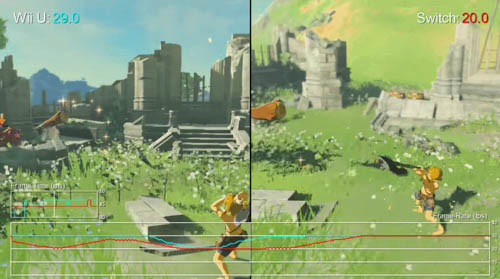
The Legend of Zelda: Breath of the Wild - Wii U (left) and Switch (right) performance
Further investigation reveals that the memory speed jump from 1331MHz in undocked mode to 1600MHz in docked mode is only a 20 percent bandwidth increase to sustain a 56 percent increase in resolution. When compared to the Wii U version of the game, some outlets have noted that the Switch will render the game slower in some areas due to a “hidden bottleneck” suggesting that the game world is partitioned differently on both platforms. At most, the difference is about 8 fps and the game is set to hard-lock at 20fps on both consoles to avoid any N64 scenarios.
As for battery life, Nintendo’s official claim is that Breath of the Wild can run for 3 hours on a single charge, though independent tests have now confirmed this number to be between 2 hours 45 minutes to 3 hours 15 minutes depending on settings.
Noise
In our living room environment, the Nintendo Switch emits a light humming noise about 30 decibels, which is about ambient room noise for a library environment. The folks at GamersNexus have done some extensive thermal testing and discovered that the console will operate at higher clock speeds under a Junction temperature of 70C, but will drop in frequency by about 6 percent between 70C and 90C. They found the system to boot at around 28C, followed by a rise to about 57C during game loads and 33 to 36dBa under heavy workloads.
In terms of load noise, a few devices for comparison would be the noise levels of any recent Intel Skylake or Kaby Lake convertible notebook on full load, or similar convertible notebook from the past three years. On average, the Nintendo Wii emitted around 32.3dB while playing games and 22dB idle, while the Wii U constantly emitted noise reminiscent of a firetruck (that was a joke).
Conclusion
Nintendo appears to have a solid release on its hands with the Switch this generation, having released the first hybrid console that will ensure many years of home and portable gameplay. An interesting question to ask is whether Wii U owners will upgrade more quickly than Nintendo DS/DSi owners, considering the console’s larger audience reach and flexible usage options.
Tablet
The tablet itself is strikingly reminiscent of Nvidia’s Shield Tablet series, and this is to be expected due to a similar design housing with a Tegra X1 processor. Admittedly, our biggest criticism is that the console’s larger bezels have subtracted away from its aesthetic value, especially with 2017 being the dawn of an age of borderless smartphones and tablet designs from several major OEMs (see: Samsung Galaxy S8, upcoming iPad Pro). Of course, some concept art shows what the Switch would look like with a 15 percent larger display size, and it is not impossible to envision an eventual refresh later down the line where the body of the tablet attaches completely flush with the Joy-Con controllers. The advantage would be twofold – more surface area for a larger display size, and a body width closer to the PlayStation Vita’s 7.23 inches (183.6mm).
Controllers
The Joy-Con controllers are fit with a lightweight and overall good build quality, very similar in nature to the Sony’s PlayStation Vita, but without the squeaky “L” and “R” shoulder buttons that can be fixed by loosening the screws. Each Joy-Con has a battery life of 20 hours, while the previous Wii Remotes used in conjunction with the Wii MotionPlus can typically last around 25 hours. In other words, a docked Nintendo Switch can be used these controls for almost a full day’s worth of non-stop gaming in the event of a marathon or similar activity.
The included Joy-Con Grip controller is a neat idea reminiscent of a squared-off GameCube controller, though it is not necessarily the most comfortable controller design offered over the past twenty years. For casual gaming, we strongly recommend either using the Joy-Con controllers separately in each hand, or considering the purchase of the Nintendo Switch Pro controller ($70). In terms of weight and size, the latter is more in line with Sony’s DualShock 4 and provides a much more comfortable grip with less thumb reach to each individual joystick and button.
Functionality
Nintendo is set to restructure its DS lineup’s market share over the next few years as a result of the Switch entering the scene, and there is little doubt that each console will include its own original games. Nintendo President Tatsumi Kimishima says that the company will continue to operate both businesses separately and in parallel, as the 3DS has unique characteristics that differ from the Switch.
The three different controller options (individual Joy-Cons, Joy-Con Grip, and Pro controller) also give the tablet a flexible range of options for interaction, and each includes the Wii and Wii U’s signature motion feedback mechanisms. For portable use, this is one area where the Switch has an upper hand over the PlayStation Vita’s integrated Sixaxis motion sensor. Sony’s inclusion of a rear touchpad on its console gives a handful of games an upper edge in tactile motion feedback, but Nintendo has instead decided to adopt untethered virtual motion controls for a wider range of in-game uses.
Another important point on mixed usage is that switching from TV Mode to handheld mode is fairly quick and seamless. The ability to dock the console into several rooms for use with multiple televisions, however, will remain a luxury for those who can afford an additional $90 per dock.
Performance
The Nintendo Switch, just like the Shield Android TV based on the same Tegra X1 SoC, is capable of hitting a target of 60fps, though most games will likely be optimized around 30fps using dynamic scaling algorithms. Yes, some games on the Tegra X1-based Shield Android TV can run anywhere between 40 to 60fps, but consider that this device isn’t portable and requires a tethered TV display. On the other hand, Nintendo has made performance adjustments necessary to balance texture efficiency with battery life. Likewise, the PlayStation Vita is capable of the same 60fps framerate, though most of its titles operate around 30fps. As for the bottom-end, games like The Legend of Zelda: Breath of the Wild on the Switch are framerate-locked at 20fps and to prevent unnecessary stuttering.
Launch games
Of course, the biggest and most important factor of purchasing any new console is the number of audience-engaging titles it affords during launch season. With the Nintendo Switch, there are only three or four decent titles aside from its blockbuster hit, The Legend of Zelda: Breath of the Wild. These include Fast RMX – a great racing game similar to Wipeout on PlayStation and F-Zero on SNES – Shovel Knight, a re-release that encapsulates the same formula from 16-bit era games like Castlevania – and Snipperclips – an interesting physics-based puzzle game developed in an anti-Mario Party fashion that allowing players to cooperate between two characters named Snip and Clip.
Pricing
The 5-inch Nintendo Switch is currently available for $299 from major retailers worldwide. In comparison, the 5-inch PlayStation Vita (Wi-Fi) is available for $249, the 8-inch Shield Tablet K1 (Kepler) is $199, and the 4.2-inch Nintendo DSi XL is currently offered at $169. With its inclusion of flexible controller options, USB-C charging, lightweight and respectable build quality, the Nintendo Switch introduces enough feature advantages and a decent leap in game quality over the DS lineup to justify the additional price. However, we could see this drop within the next year once the company builds out its larger arsenal of independent, creative, and best-selling hits for the platform. Thankfully, there will be no region locking with the world’s first hybrid home-portable console, and this importantly allows it to maintain an equal playing field with Android and iOS development in the coming years.

